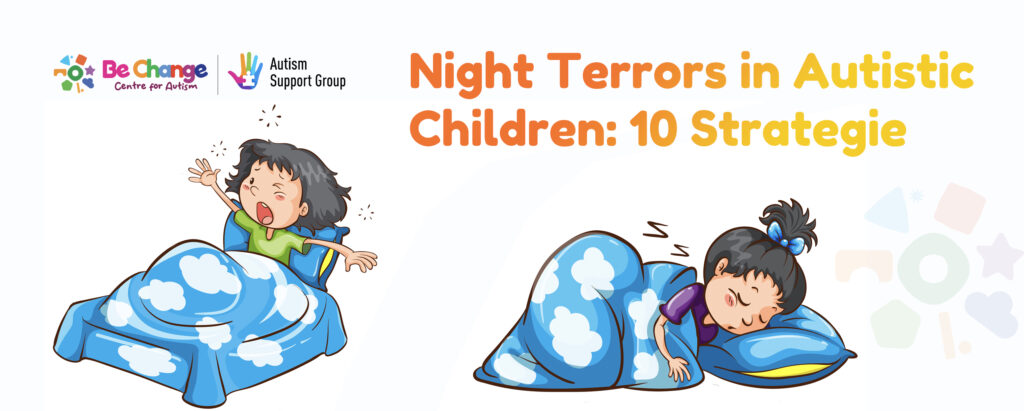
Introduction: Why Night Terrors Affect Autistic Children
Night terrors in autistic children can be overwhelming for both the child and the parents. Unlike nightmares, night terrors often occur during deep sleep and may cause sudden screaming, sweating, or thrashing — even though the child is not fully awake.
Children on the autism spectrum are more prone to sleep disturbances due to sensory sensitivities, anxiety, and irregular sleep patterns. The good news is that there are gentle, sensory-friendly strategies that can help prevent or reduce night terrors while making bedtime a calmer, more enjoyable experience.
Below are 10 creative and practical approaches parents and caregivers can try.
Connect with us : https://www.facebook.com/bechangecentre
1. Sensory-Friendly Bedtime Corner for Autistic Children
Create a designated sleep space that caters to your child’s sensory needs. Use soft, calming colors and incorporate different textures such as plush pillows, velvety blankets, or silk sheets. Adding a small indoor fountain or white noise machine can provide soothing background sounds.
Autistic children often find comfort in specific textures and sensory input, so tailoring the environment can enhance their sense of security and reduce sleep-related anxiety.
2. Dream Catcher Ritual
Introduce your child to the concept of a dream catcher. Together, create one and explain how it “traps bad dreams” while letting only the good ones through. Hang it above their bed to provide a sense of control and reassurance at bedtime.
This imaginative ritual can empower your child and ease nighttime fears.
3. Nighttime Stargazing with a Projector
Install a ceiling projector that displays a starry night sky or moving galaxies. Encourage your child to “stargaze” before sleep, turning bedtime into a calming, magical adventure.
This visual focus diverts attention from nighttime worries and encourages relaxation.
4. Magic Sleep Spray Ritual
Make a bedtime ritual with a DIY “magic sleep spray.” Fill a spray bottle with water and add a few drops of calming essential oils like lavender or chamomile. Together with your child, spray the room before bedtime, framing it as a charm that keeps away bad dreams.
This fun activity helps the child feel empowered and calm before sleep.
5. Personalized Bedtime Stories
Tell stories where your child is the hero — overcoming challenges and finding safety. Incorporate their favorite characters, hobbies, and interests.
These positive bedtime narratives boost confidence and set a calm, happy mindset before drifting off to sleep.
6. Interactive Breathing Games
Turn relaxation into play with simple breathing games. For example, encourage your child to “breathe like the ocean” by inhaling deeply and exhaling slowly, imitating waves.
This technique makes relaxation engaging while teaching self-soothing skills.
7. Glow-in-the-Dark Reward System
Create a reward chart using glow-in-the-dark star stickers. Each night without a night terror (or with successful self-soothing), your child earns a star. After a certain number of stars, reward them with a favorite treat, toy, or activity.
Positive reinforcement helps children look forward to bedtime.
8. Soothing Sensory Bottles
Make sensory bottles filled with water, glitter, and calming colors. Watching the glitter slowly settle is a visual relaxation tool that autistic children often find soothing.
Use this as a pre-sleep calming activity.
9. Themed Sleep Adventure
Transform bedtime into a themed adventure, such as an “Underwater Exploration” or a “Space Voyage.” Use matching nightlights, stuffed animals, or bedding to enhance the experience.
Engaging the imagination can replace bedtime anxiety with excitement and curiosity.
10. Positive Affirmation Cards
Create affirmation cards with calming statements like:
-
“I am safe.”
-
“My dreams are happy.”
-
“I am brave.”
Encourage your child to choose a card each night and repeat the affirmation. These positive messages build security and confidence.
Bonus: When to Seek Professional Help
If night terrors are frequent or severe, consult a pediatrician, sleep specialist, or occupational therapist. In some cases, sleep difficulties may be linked to underlying anxiety, sensory processing challenges, or medical conditions that require professional support.
Parents in Bangalore can also explore resources like the Safe ABA Therapy Center in Bangalore, which provides guidance and structured strategies for improving sleep routines in autistic children.
Read about creating a Bed Time routine of Autistic Kids
